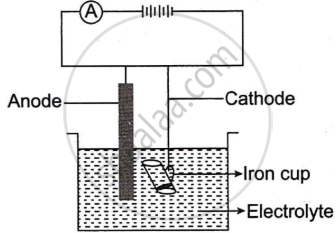Advertisements
Advertisements
Question
Give the equation for the reduction of Iron (III) oxide.
Solution
The reduction of iron (III) oxide by carbon monoxide takes place according to the following equation:
\[\ce{Fe2O3 + 3CO -> 2Fe + 3CO2}\]
APPEARS IN
RELATED QUESTIONS
Name the following:
A metal oxide that can be reduced by hydrogen.
How is the following metallic oxide reduced? Write the equation:
Zinc oxide
Name a non-metallic element which is a conductor of electricity.
Complete the following by selecting the correct option from the choices given :
The metal whose oxide, which is amphoteric, is reduced to metal by carbon reduction ________
Complete the following by selecting the correct option from the choices given :
The diavalent metal whose oxide is reduced to metal by electrolysis of its fused salt is ________
Write the observation for the following:
A paper dipped in potassium permanganate solution is put on the mouth of a test tube containing sulphur dioxide gas.
- A to F below relate to the source and extraction of either zinc or aluminium:
- Bauxite
- Coke
- Cryolite
- Froth floatation
- Sodium hydroxide solution
- Zinc blende
- Write down the three letters each from the above list which are relevant to
- Zinc
- Aluminium
- Fill in the blanks using the most appropriate words from A to F.
- The ore from which aluminium is extracted must first be treated with ………………. so that pure aluminium oxide can be obtained.
- Pure aluminium oxide is dissolved in ….. to make a conducting solution.
iii. Write the formula of cryolite.
Steel is an alloy of iron and ______.
Name two metallic oxides which cannot be reduced by carbon, carbon monoxide or hydrogen.
The following sketch represents the electroplating of an Iron cup with Nickel metal.
Study the diagram and answer the following questions:

- During electroplating, the iron cup is placed at the cathode. Why?
- Name the ion that must be present in the electrolyte.
- State one condition that is necessary to ensure that the deposit is smooth, firm and even.
- Write the reaction taking place at the cathode.
- What change would you observe at the anode?
